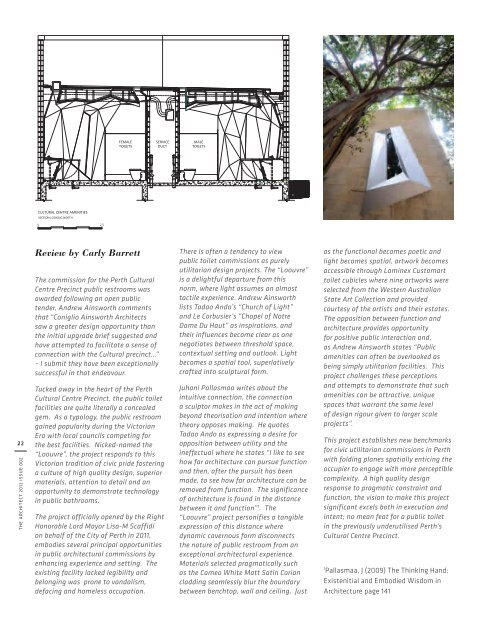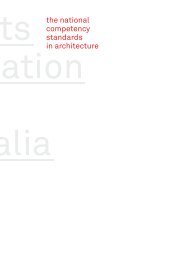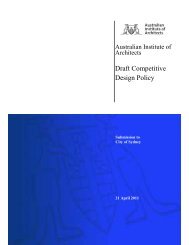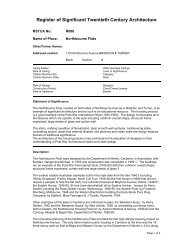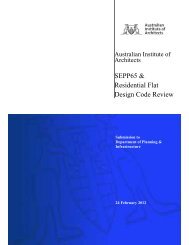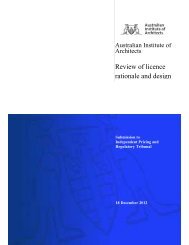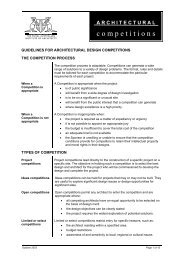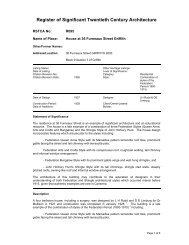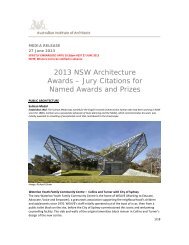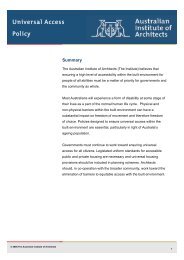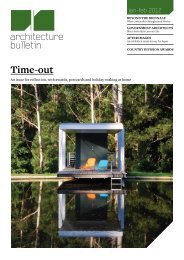Winter - Australian Institute of Architects
Winter - Australian Institute of Architects
Winter - Australian Institute of Architects
- No tags were found...
Create successful ePaper yourself
Turn your PDF publications into a flip-book with our unique Google optimized e-Paper software.
22THE ARCHITECT 2012 ISSUE 002Review by Carly BarrettThe commission for the Perth CulturalCentre Precinct public restrooms wasawarded following an open publictender, Andrew Ainsworth commentsthat “Coniglio Ainsworth <strong>Architects</strong>saw a greater design opportunity thanthe initial upgrade brief suggested andhave attempted to facilitate a sense <strong>of</strong>connection with the Cultural precinct…”– I submit they have been exceptionallysuccessful in that endeavour.Tucked away in the heart <strong>of</strong> the PerthCultural Centre Precinct, the public toiletfacilities are quite literally a concealedgem. As a typology, the public restroomgained popularity during the VictorianEra with local councils competing forthe best facilities. Nicked-named the“Loouvre”, the project responds to thisVictorian tradition <strong>of</strong> civic pride fosteringa culture <strong>of</strong> high quality design, superiormaterials, attention to detail and anopportunity to demonstrate technologyin public bathrooms.The project <strong>of</strong>ficially opened by the RightHonorable Lord Mayor Lisa-M Scaffidion behalf <strong>of</strong> the City <strong>of</strong> Perth in 2011,embodies several principal opportunitiesin public architectural commissions byenhancing experience and setting. Theexisting facility lacked legibility andbelonging was prone to vandalism,defacing and homeless occupation.There is <strong>of</strong>ten a tendency to viewpublic toilet commissions as purelyutilitarian design projects. The “Loouvre”is a delightful departure from thisnorm, where light assumes an almosttactile experience. Andrew Ainsworthlists Tadao Ando’s “Church <strong>of</strong> Light”and Le Corbusier’s “Chapel <strong>of</strong> NotreDame Du Haut” as inspirations, andtheir influences become clear as onenegotiates between threshold space,contextual setting and outlook. Lightbecomes a spatial tool, superlativelycrafted into sculptural form.Juhani Pallasmaa writes about theintuitive connection, the connectiona sculptor makes in the act <strong>of</strong> makingbeyond theorisation and intention wheretheory opposes making. He quotesTadao Ando as expressing a desire foropposition between utility and theineffectual where he states “I like to seehow far architecture can pursue functionand then, after the pursuit has beenmade, to see how far architecture can beremoved from function. The significance<strong>of</strong> architecture is found in the distancebetween it and function” 1 . The“Loouvre” project personifies a tangibleexpression <strong>of</strong> this distance wheredynamic cavernous form disconnectsthe nature <strong>of</strong> public restroom from anexceptional architectural experience.Materials selected pragmatically suchas the Cameo White Matt Satin Coriancladding seamlessly blur the boundarybetween benchtop, wall and ceiling. Justas the functional becomes poetic andlight becomes spatial, artwork becomesaccessible through Laminex Customarttoilet cubicles where nine artworks wereselected from the Western <strong>Australian</strong>State Art Collection and providedcourtesy <strong>of</strong> the artists and their estates.The opposition between function andarchitecture provides opportunityfor positive public interaction and,as Andrew Ainsworth states “Publicamenities can <strong>of</strong>ten be overlooked asbeing simply utilitarian facilities. Thisproject challenges these perceptionsand attempts to demonstrate that suchamenities can be attractive, uniquespaces that warrant the same level<strong>of</strong> design rigour given to larger scaleprojects”.This project establishes new benchmarksfor civic utilitarian commissions in Perthwith folding planes spatially enticing theoccupier to engage with more perceptiblecomplexity. A high quality designresponse to pragmatic constraint andfunction, the vision to make this projectsignificant excels both in execution andintent; no mean feat for a public toiletin the previously underutilised Perth’sCultural Centre Precinct.1Pallasmaa, J (2009) The Thinking Hand;Existenitial and Embodied Wisdom inArchitecture page 141


